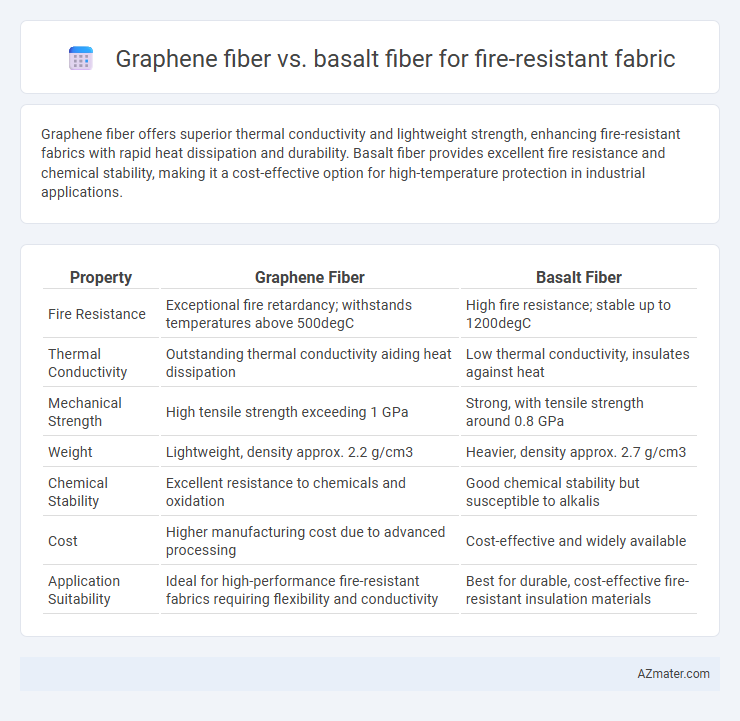Graphene fiber offers superior thermal conductivity and lightweight strength, enhancing fire-resistant fabrics with rapid heat dissipation and durability. Basalt fiber provides excellent fire resistance and chemical stability, making it a cost-effective option for high-temperature protection in industrial applications.
Table of Comparison
| Property | Graphene Fiber | Basalt Fiber |
|---|---|---|
| Fire Resistance | Exceptional fire retardancy; withstands temperatures above 500degC | High fire resistance; stable up to 1200degC |
| Thermal Conductivity | Outstanding thermal conductivity aiding heat dissipation | Low thermal conductivity, insulates against heat |
| Mechanical Strength | High tensile strength exceeding 1 GPa | Strong, with tensile strength around 0.8 GPa |
| Weight | Lightweight, density approx. 2.2 g/cm3 | Heavier, density approx. 2.7 g/cm3 |
| Chemical Stability | Excellent resistance to chemicals and oxidation | Good chemical stability but susceptible to alkalis |
| Cost | Higher manufacturing cost due to advanced processing | Cost-effective and widely available |
| Application Suitability | Ideal for high-performance fire-resistant fabrics requiring flexibility and conductivity | Best for durable, cost-effective fire-resistant insulation materials |
Introduction to Fire-Resistant Fabrics
Fire-resistant fabrics are engineered to inhibit combustion and protect against extreme heat, making them essential in safety gear and industrial applications. Graphene fiber offers exceptional thermal conductivity and mechanical strength, enhancing fire resistance by dissipating heat rapidly. Basalt fiber provides inherent fire resistance due to its natural mineral composition, maintaining structural integrity at temperatures exceeding 1000degC.
Overview of Graphene Fiber
Graphene fiber exhibits exceptional thermal conductivity and tensile strength, making it highly effective for fire-resistant fabric applications. Its unique atomic structure allows rapid heat dissipation, reducing the risk of combustion and enhancing durability under extreme temperatures. Compared to basalt fiber, graphene fiber offers superior flexibility and lighter weight, contributing to improved comfort and performance in protective clothing.
Overview of Basalt Fiber
Basalt fiber, derived from volcanic rock, offers exceptional fire resistance with a melting point exceeding 1400degC, making it highly suitable for fire-resistant fabrics in extreme conditions. Its excellent thermal stability, chemical inertness, and mechanical strength surpass many conventional fibers, providing durability and safety in protective clothing and industrial applications. Unlike graphene fiber, basalt fiber ensures cost-effective production and scalability while maintaining superior insulation and non-combustibility.
Fire Resistance Properties: Graphene vs Basalt
Graphene fiber exhibits superior fire resistance properties due to its exceptional thermal conductivity and stability, enabling it to dissipate heat rapidly and maintain structural integrity at temperatures exceeding 3,000degC. Basalt fiber also offers impressive fire resistance, withstanding temperatures up to 1,000degC without melting or releasing toxic fumes, making it highly effective for fireproof fabrics. However, graphene fibers outperform basalt in thermal management, providing faster heat dissipation and enhanced durability under extreme fire exposure conditions.
Thermal Stability and Insulation Compared
Graphene fiber exhibits superior thermal stability withstanding temperatures up to 600degC without degradation, outperforming basalt fiber which typically resists up to 400-600degC depending on processing. Graphene's exceptional heat conductivity allows efficient dissipation of thermal energy, enhancing insulation properties in fire-resistant fabrics. Basalt fiber offers good thermal insulation due to its natural mineral composition but lacks the high thermal stability and lightweight advantages of graphene fiber in extreme fire protection applications.
Mechanical Strength and Durability
Graphene fiber exhibits exceptional mechanical strength with tensile strength surpassing 130 GPa, making it one of the strongest known materials for fire-resistant fabrics. Basalt fiber, while also robust, has tensile strength typically around 2.8 GPa but offers superior chemical stability and thermal resistance up to 800degC, enhancing durability in high-temperature environments. The combination of graphene's high strength and basalt fiber's heat resistance results in fire-resistant fabrics with optimal durability for demanding applications.
Applications in Fire-Resistant Textiles
Graphene fiber offers exceptional thermal conductivity and mechanical strength, enhancing fire-resistant textiles used in firefighter gear and aerospace applications by providing superior heat dissipation and durability. Basalt fiber excels in high-temperature resistance and chemical stability, making it ideal for industrial protective clothing, insulation materials, and fire barriers in construction. Both fibers improve safety performance, with graphene fiber emphasizing lightweight flexibility and basalt fiber focusing on cost-effective high-temperature endurance in fire-resistant fabric applications.
Environmental Impact and Sustainability
Graphene fiber exhibits superior environmental benefits in fire-resistant fabrics due to its renewable production methods and high efficiency requiring less material usage compared to basalt fiber, which is derived from natural volcanic rock through energy-intensive melting processes. Basalt fiber production generates significant carbon emissions and energy consumption, whereas graphene fibers support sustainability goals by reducing raw material extraction and promoting recyclability. The integration of graphene in fire-resistant textiles enhances durability and longevity, minimizing waste and lowering the overall environmental footprint compared to basalt fiber alternatives.
Cost and Availability Analysis
Graphene fiber offers superior fire resistance and mechanical strength but remains costly due to complex manufacturing processes and limited large-scale production facilities. Basalt fiber provides a more affordable alternative with widespread availability, sourced from abundant volcanic rock and produced using established, scalable methods. When evaluating fire-resistant fabrics, basalt fiber presents a cost-effective option with reliable supply chains, whereas graphene fiber is suited for high-end applications where performance justifies higher expense.
Conclusion: Choosing the Optimal Fire-Resistant Fiber
Graphene fiber offers exceptional thermal conductivity and lightweight durability, making it ideal for advanced fire-resistant fabrics requiring flexibility and high heat dissipation. Basalt fiber provides superior fire resistance, chemical stability, and cost-effectiveness, preferred in industrial applications demanding robust flame retardance and mechanical strength. Selecting the optimal fire-resistant fiber depends on prioritizing either enhanced thermal performance and flexibility with graphene or cost-efficient, high-temperature stability with basalt fiber.

Infographic: Graphene fiber vs Basalt fiber for Fire-resistant fabric
 azmater.com
azmater.com